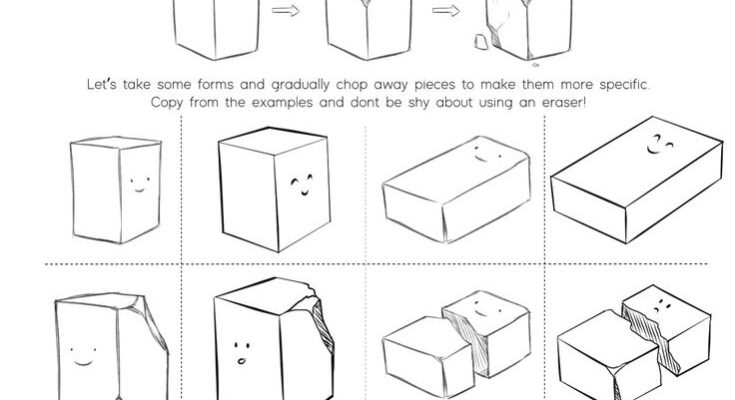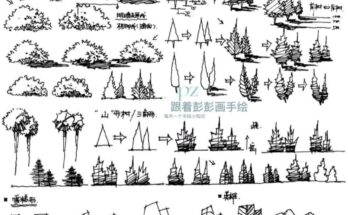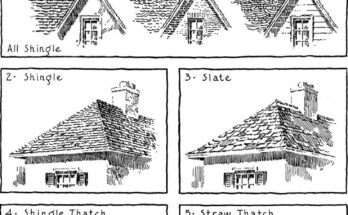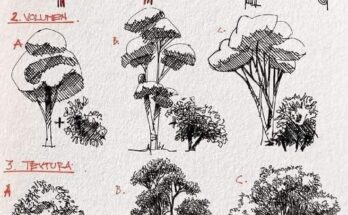From Blocks to Forms: Understanding “Sculpting” in Drawing for Beginners

This tutorial page, “Basics of Drawing: Sculpting by JeyRam,” introduces a dynamic and intuitive approach to drawing three-dimensional forms. Often, beginners struggle with making objects look solid and realistic. This lesson tackles that challenge by presenting a “sculpting” mindset, encouraging artists to think about carving or shaping forms rather than just outlining them.
The “Sculpting” Mindset Explained:
The core idea presented here is to “think of the base shapes as slabs of marble and then chop away pieces to make them more specific forms.” This analogy is incredibly powerful. Instead of trying to draw a complex object directly, you start with a simpler, foundational geometric shape (like a cube, as shown) and then progressively refine it by imagining you’re removing material. This method helps to:
- Build Confidence: Starting with a basic form is less intimidating than tackling a complex object head-on.
- Improve Spatial Reasoning: It forces you to visualize the object in 3D, understanding its volume and how different planes connect.
- Enhance Form Understanding: By “chopping away,” you naturally consider the mass and structure of the object, rather than just its outline.
- Achieve a Sense of Solidity: This subtractive process inherently leads to drawings that feel more grounded and substantial.
Key Concepts and Exercises:
The tutorial provides clear visual examples and practice prompts:
- Initial Transformation (Top Section): The top row illustrates the concept with a simple cube. It shows how starting with a basic block, you can then “chop” off corners or sections to create a more specific, albeit still geometric, form. This visually demonstrates the process of reducing a larger mass into a desired shape. This process helps build an “illusion of 3D on the page.”
- Progressive “Chopping” Exercises (Bottom Section): The main grid of exercises takes this concept further, presenting various forms and encouraging the artist to “gradually chop away pieces to make them more specific.”
- Simple Cube Refinements: The first few examples start with a basic cube and show different ways to remove sections, creating unique, irregular but solid-looking forms. Notice the subtle addition of “faces” to some of the blocks, which adds a touch of personality and can make the learning process more engaging for younger artists or those who appreciate a playful touch.
- Rectangular Block Variations: The tutorial then moves to rectangular blocks, demonstrating how the same “sculpting” principle applies, leading to elongated or flattened forms with sections removed.
- Organic and Rough Forms: Later examples show more complex and organic “sculpted” shapes, some looking like rough-hewn stone or natural geological formations. This pushes the artist to apply the concept to less perfectly geometric starting points.
- Emphasis on Erasing: The instruction, “Copy from the examples and don’t be shy about using an eraser!” is critical. This reinforces that drawing is an iterative process. Mistakes are part of learning, and the eraser is a tool for refinement, allowing you to “remove” material just as a sculptor would.
How This Tutorial Benefits Beginners:
- Demystifies Complex Forms: By breaking down complex objects into simpler, sculptable components, it makes drawing intricate shapes less daunting.
- Fosters a 3D Mindset: It trains the eye and hand to think in terms of volume, planes, and masses, which is foundational for all forms of drawing.
- Encourages Iteration and Experimentation: The “chopping” and “erasing” approach promotes a fearless attitude towards drawing.
- Prepares for More Advanced Techniques: This understanding of form and volume is crucial for later lessons in shading, perspective, and figure drawing.
Practical Application:
The “sculpting” approach isn’t just for abstract blocks. It can be applied to virtually anything you draw:
- Figure Drawing: Start with basic geometric forms for the torso, limbs, and head, then “sculpt” away to define muscles and specific features.
- Still Life: Begin with simple boxes, cylinders, or spheres for objects, then refine them.
- Character Design: Block out character forms before adding details.
- Environmental Art: Construct buildings and landscapes from basic volumetric shapes.
Conclusion:
“Basics of Drawing: Sculpting” by JeyRam is an excellent, hands-on tutorial that shifts a beginner’s perspective from line-centric drawing to form-centric drawing. By embracing the idea of shaping and refining from a basic mass, artists can build a strong foundation for creating drawings that possess genuine depth, solidity, and realism. This lesson is a vital stepping stone in the journey of becoming a proficient artist.



